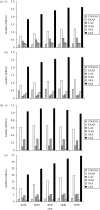Livestock production: recent trends, future prospects
- PMID: 20713389
- PMCID: PMC2935116
- DOI: 10.1098/rstb.2010.0134
Livestock production: recent trends, future prospects
Abstract
The livestock sector globally is highly dynamic. In developing countries, it is evolving in response to rapidly increasing demand for livestock products. In developed countries, demand for livestock products is stagnating, while many production systems are increasing their efficiency and environmental sustainability. Historical changes in the demand for livestock products have been largely driven by human population growth, income growth and urbanization and the production response in different livestock systems has been associated with science and technology as well as increases in animal numbers. In the future, production will increasingly be affected by competition for natural resources, particularly land and water, competition between food and feed and by the need to operate in a carbon-constrained economy. Developments in breeding, nutrition and animal health will continue to contribute to increasing potential production and further efficiency and genetic gains. Livestock production is likely to be increasingly affected by carbon constraints and environmental and animal welfare legislation. Demand for livestock products in the future could be heavily moderated by socio-economic factors such as human health concerns and changing socio-cultural values. There is considerable uncertainty as to how these factors will play out in different regions of the world in the coming decades.
Figures



References
-
- Audsley E., Brander M., Chatterton J., Murphy-Bokern D., Webster C., Williams A.2009How low can we go? An assessment of greenhouse gas emissions from the UK food system and the scope to reduce them by 2050. FCRN-WWF-UK. Online at assets.wwf.org.uk/downloads/how_low_report_1.pdf
-
- Bio-Era (Bio Economic Research Associates) 2008Economic impact of selected infectious diseases. See http://www.bio-era.net/reports/biosecurity/bsec_econ_impact.html
-
- Bruinsma J.2003World agriculture: towards 2015/2030, an FAO perspective. Rome, Italy: Earthscan, FAO
-
- Brunori G., Jiggins J., Gallardo R., Schmidt O.2008The Second SCAR Foresight Exercise, Synthesis Report, ‘New challenges for agricultural research: climate change, food security, rural development, agricultural knowledge systems’, p. 105 EU Commission Standing Committee on Agricultural Research (SCAR)
-
- Burton R., Mansfield L., Schwarz G., Brown K., Convery I. Social capital in hill farming: report for the Upland Centre. 2005. See http://www.theuplandcentre.org.uk/pubs.htm .
Publication types
MeSH terms
LinkOut - more resources
Full Text Sources

